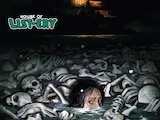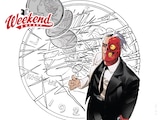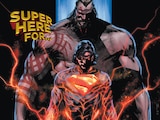At DC, 2023 has been a banner year for the classics. The launch of the New Golden Age under Geoff Johns has given us a new series for the Justice Society of America, and now three new comics for some of the original superhero team’s founding members: Jay Garrick, the Golden Age Flash; Alan Scott, the Golden Age Green Lantern; and, most exciting for some of us, Wesley Dodds, the Golden Age Sandman.
In one incarnation or another, mantles like the Flash and Green Lantern have maintained a steady presence on DC’s monthly release shelves for eighty years. But for those who have fallen under the spell of the Sandman, the return of Wesley Dodds represents a rarer treat. Written by Robert Venditti, who revitalized Hawkman in 2018 with Bryan Hitch, and with art by Riley Rossmo, who changed the way we think about J’onn J’onzz in 2018’s Martian Manhunter, Wesley Dodds: The Sandman represents a convergence of two creators known for drawing fresh attention to classic characters. But for those of you approaching this gas masked mystery man with the sands of sleep still in your eyes, we’re here to awaken you to the truth about Wesley Dodds.

Who is Wesley Dodds?
Wesley Dodds is a man with a dream. It’s not a very good dream. In fact, it’s a dream he’d rather do without. Every night, a new crime comes to his restless mind, compelling him to catch that criminal so the rest of New York City can rest easier. To accomplish his nighttime task, he dons the fearsome identity of the Sandman.
Created by Gardner Fox and Bert Christman, Wesley Dodds was one of DC’s very first crimefighting costumed heroes, just a scant month younger than Batman. Like many heroes of his time, he was a wealthy man of means whose parents’ untimely demise granted him the dispensation to use the resources at his disposal towards the purpose of justice. But unlike most of his contemporaries, the Sandman was often seen solving mysteries alongside his romantic partner, Dian Belmont, an equal companion in his early adventures. When the Justice Society of America first gathered around the table in 1941, the Sandman was there alongside the likes of Doctor Fate, Hourman and the Spectre.

Does He Have Any Powers?
Not really, no. Wesley Dodds uses his prodigious martial arts training, chemical knowledge, skills of deduction, talent for theatricality and a gas gun which puts his enemies to sleep in the name of fighting crime.
Well, all right. He has ONE power, but he’d rather not have it. It’s his prophetic ability to detect crimes in his sleep. Until he catches that criminal, Wesley Dodds cannot rest. Some heroes are motivated by the death of a loved one or the responsibility of a great gift of power. All Wesley Dodds really wants is a good night’s sleep.

What’s the Deal with that Gas Mask?
The practical purpose is to shield himself from the gas he uses while crimefighting. But there’s also an undeniable fear factor attached. The inhuman visage the gas mask presents is a surefire way to disarm your foes with fear—not just in how it distorts the facial features, but in the way it symbolically represents the specter of World War I trench warfare still haunting America in the late 1930s. As we get to know Wesley Dodds, we learn that he lost his own beloved father to the war, the mask taking on a new meaning as the cloak of that which he fears most. Not at all unlike Batman’s own relationship to the bat, but with a symbol far more viscerally relatable to the men of his era.

How is He Related to the Other Sandmans—er, Sandmen?
Let’s go with Sandsman. Wesley Dodds was the original Sandman—at least, in publication order—and each subsequent bearer of the standard has represented a complete reinvention of the concept from the ground up. It’s like how in the Golden Age, the Atom was just a short wrestler, but by the Silver Age, he was a shrinking scientist.
In the 1970s, Jack Kirby and Joe Simon, whose careers at DC started with work on the original Sandman feature, recreated the Sandman concept as one more in line with the actual Sandman of folklore, an eternal figure who watched over our dreams as a psychic guardian, albeit one clad in a Jack Kirby superhero costume. Roy Thomas would write a backstory for this Sandman in 1983 as the once-human Garrett Sanford, a psychology professor trapped in the Dream Dimension who takes on the mantle of the Sandman. After Sanford passes away, he is succeeded in his role by Hector Hall, formerly Silver Scarab of Infinity Inc and son to Hawkman and Hawkwoman.
The most well-known Sandman, though, is the figure who ties these entities together, although he rarely uses the name “Sandman” himself: Neil Gaiman, Sam Kieth and Mike Dringenberg’s Dream of the Endless, protagonist of the classic Vertigo Sandman series. A primordial god of stories, Dream was ensnared by an immortality cult for most of the 20th century, during which time, the universe conspired to create figures which would fill the totemic void of Dream’s absence, motivating figures like Wesley Dodds to quell disturbed dreams of injustice and impelling the rogue nightmares Brute and Gob to lure Garrett Sanford and Hector Hall into the Dream Dimension.
From Wesley Dodds’ mere mortal perspective, however, suffice to say there’s no relation whatsoever.

What’s the Deal with Sandy the Golden Boy?
Look, it was 1941. Robin had just shown up in Detective Comics and the whole concept of a kid sidekick was a really, really big deal. If you were a superhero with your own feature at the time that wasn’t already selling like Superman, it was hard to say no to the popularity boost that came from inserting a child into the danger that the primary audience of young readers could project themselves into. In that spirit, Mort Weisinger and Paul Norris introduced Sandy Hawkins, a Sandman fan and nephew to Wesley Dodds’ girlfriend.
For these adventures, Wesley Dodds put away his gas mask and donned a more traditional superhero costume as an update for more caped crusading times. Sandy continued appearing as Wesley’s crimefighting partner until 1945. Soon after, the young sidekick would stop appearing in Sandman adventures and Wesley returned to his classic costume—a mysterious off-page reversion which Len Wein would eventually explore in 1987’s DC Comics Presents #47, revealing the tragedy wherein Sandy was transformed into a horrible sand creature.
But don’t feel too bad. This new status quo for Sandy would prove an asset to him as the superhero Sand, taking up his mentor’s place in the reformed JSA of the 1990s. And like Wesley before him, he too is spurred onward by prophetic dreams of injustice.

So, is Wesley Dodds Alive or Dead?
Unlike most founding members of the JSA, who managed to get to the present relatively unscathed by the ravages of age thanks to their powers, time travel, or some chance encounter with demonic forces, Wesley Dodds experienced the decades from the Golden Age onward in the regular way, getting older as humans do. An old man of failing health by the 1990s, Wesley liquidated his fortunes to spend his remaining years traveling the world with his love Dian, occasionally lending a hand to the likes of Starman or the reformed JSA before sacrificing himself in a confrontation with Mordru to preserve the identity of the new Doctor Fate.
Most recently, Wesley returned from the grave just for one night in his surprise star turn during this year’s Knight Terrors, while the new Wesley Dodds series will take us back to the 1940s to revisit the soldier of slumber in his prime.

Okay, We’ll Bite. What Makes Him Such a Fan Favorite?
As the timeline of heroism has advanced, with Batman and Superman forever readjusting themselves to contemporary heroism, the Sandman has always remained in the era of his first adventures, standing as a symbol of the earliest era of urban costumed crimefighting. Wesley Dodds may not be the first superhero, but over time, as the guardian who has been allowed to be left behind, the original Sandman has come to stand in as the ultimate representative for the first age of heroism.
To fans of comic book history, Wesley Dodds is the champion of the costumed man of mystery in its very first guise, one where human skill matched with superhuman courage was the recipe for battling the greatest ills society could offer and everyday systemic corruption was a larger threat than any death ray or flying saucer. The Sandman is a more grounded kind of hero, who exists so that we might rest easier knowing that, even as we sleep, the course of justice cannot be stopped. And that’s why we love Wesley Dodds. Pleasant dreams.
Wesley Dodds: The Sandman #1 by Robert Venditti, Riley Rossmo and Ivan Plascencia is now available in print and as a digital comic book.
Alex Jaffe is the author of our monthly "Ask the Question" column and writes about TV, movies, comics and superhero history for DC.com. Follow him on Bluesky at @AlexJaffe and find him in the DC Community as HubCityQuestion.




















